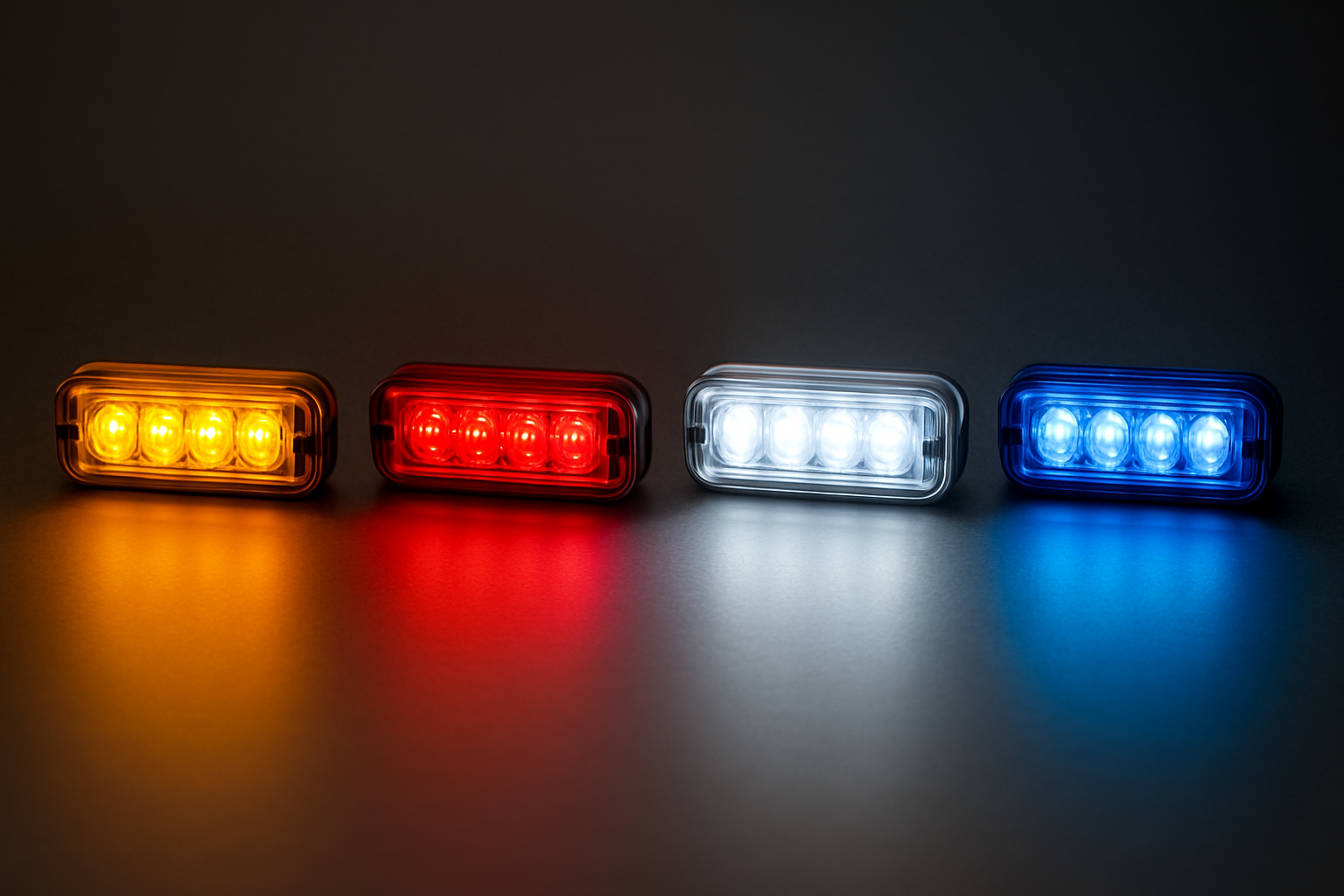When it comes to emergency vehicle lighting, color isn't just about aesthetics—it's about safety, visibility, and compliance. Whether you're outfitting a police cruiser, fire truck, tow vehicle, or construction equipment, understanding color temperature and making the right LED color choice can make all the difference in being seen when it matters most.
What Is Color Temperature and Why Does It Matter?
Color temperature, measured in Kelvin (K), describes the appearance of light from a source. Lower temperatures (2000K-3000K) produce warm, yellowish light, while higher temperatures (5000K-6500K) create cool, bluish-white light. For emergency vehicles and warning applications, color temperature directly impacts visibility in various conditions.
The right color choice ensures your lights are visible day or night, rain or shine, providing the safety and visibility needed for emergency response vehicles. But beyond just being seen, color selection also relates to legal requirements and specific industry applications.
Understanding Emergency Vehicle Color Regulations
Before diving into color choices, it's essential to understand that emergency vehicle lighting colors are regulated in most jurisdictions:
-
Red: Typically restricted to fire departments, ambulances, and some police vehicles
-
Blue: Often designated for law enforcement use only
-
Amber/Yellow: Generally permitted for tow trucks, utility vehicles, construction equipment, and private security
-
White: Commonly used as auxiliary lighting and can be paired with other colors
-
Green: Sometimes used for command vehicles or volunteer firefighters in some regions
Local laws vary significantly, so always check your specific state and municipal regulations before installing any emergency lighting.
Breaking Down LED Colors by Application
Red LED Lights (620-750nm)
Red lights have one of the longest wavelengths in the visible spectrum, making them highly effective at cutting through fog, rain, and dust. This is why they're a staple for fire departments and ambulances.
[Shop UBL’s Red Warning Lights]
Best Applications for Red LEDs:
-
Fire trucks and apparatus
-
Ambulances and EMS vehicles
-
Rear warning lights on police vehicles
-
Emergency brake lights
Red creates an immediate sense of urgency and is recognizable even at considerable distances. Fire departments typically use a combination of red and white LEDs to maximize visibility in all conditions.
Blue LED Lights (450-495nm)
Blue has become synonymous with law enforcement for good reason. Its shorter wavelength creates a striking contrast against most environmental backgrounds, especially during daylight hours.
Best Applications for Blue LEDs:
-
Police vehicles
-
Sheriff and highway patrol units
-
Federal law enforcement
-
Security vehicles (where permitted)
Many police departments utilize a combination of blue and white light bars to create a distinctive, highly visible pattern that's immediately recognizable as law enforcement.
[Shop UBL’s Blue Warning Lights]
Amber/Yellow LED Lights (570-590nm)
Amber sits in the middle of the visible spectrum and offers excellent visibility in both day and night conditions. It's generally the most universally permitted warning light color.
Best Applications for Amber LEDs:
-
Construction vehicles
-
Tow trucks and roadside assistance
-
Utility vehicles
-
Snow plows
-
School buses
-
Civilian hazard warnings
Amber warning lights have become standard for vehicles that need to alert others without causing confusion with emergency services. They provide strong visibility without the immediate "emergency" association that red or blue lights carry.
[Shop UBL’s Amber Warning Lights]
White LED Lights (All Visible Wavelengths)
White light contains all visible wavelengths and provides the highest level of general illumination. It's exceptionally effective as a work light or when paired with other colors.
Best Applications for White LEDs:
-
Scene lighting
-
Work areas
-
Takedown lights
-
Alley lights
-
Flood and spot beams
-
Secondary warning in combination with other colors
White LEDs are particularly effective in lighting up a work area or providing additional visibility when paired with colored warning lights.
Green LED Lights (495-570nm)
While less common in emergency vehicle applications, green LEDs have specific uses in the emergency response community.
Best Applications for Green LEDs:
-
Command vehicles at incident scenes
-
Volunteer firefighter personal vehicles (in some jurisdictions)
-
Hospital emergency entrance markers
-
Incident command posts
Green offers good visibility and a distinct color that won't be confused with the more common red and blue emergency lights.
[Shop UBL’s Green Warning Lights]
Color Temperature Selection for Maximum Effectiveness
When selecting LEDs for specific applications, consider these factors that impact visibility and effectiveness:
Daytime vs. Nighttime Visibility
Different colors perform differently depending on lighting conditions:
-
Daytime: Blue and white lights tend to be most visible in bright sunlight
-
Nighttime: Red and amber lights stand out effectively against darkness
-
Fog and Rain: Red lights penetrate atmospheric moisture better than blue or white
For comprehensive 24-hour visibility, many professional vehicles combine complementary colors that perform well in various conditions.
Distance Perception and Color
Color also affects how distance is perceived:
-
Red appears closer than it actually is
-
Blue often seems farther away
-
Yellow/amber draws immediate attention due to its wavelength
-
White provides the strongest overall illumination
This is why traffic advisor light bars often use amber—they need to be noticed quickly but shouldn't cause drivers to overreact by appearing too close.
LED Color Quality and Performance Factors
Not all LEDs are created equal, and several factors determine the quality and effectiveness of colored LEDs:
Color Consistency and Purity
Lower-quality LEDs often have inconsistent color output or may shift in color as they age. Premium LED emergency lights maintain color consistency throughout their lifespan, ensuring your warning lights remain compliant and effective.
Look for LEDs with high color purity ratings to ensure the clearest, most vibrant output in all conditions.
Intensity and Output
The brightness of LEDs is measured in lumens, but intensity perception varies by color. Yellow is perceived as brightest to the human eye, followed by green, while blue appears less bright even at the same lumen level.
High-quality LEDs, like those from Feniex Industries, are designed with optimal output levels calibrated for each color to ensure maximum visibility regardless of the wavelength.
Weather Resistance and Environmental Performance
Emergency lights must perform in all weather conditions. Quality LED housings should be fully sealed and rated for harsh environments. The best emergency lights on the market are tested in real-world environments to ensure optimal performance when first responders need them most.
Modern Innovations in LED Color Technology
The emergency lighting industry continues to evolve with new technologies expanding color capabilities:
Multi-Color and Color-Changing LEDs
Advanced products like the Feniex Quantum series offer up to 5-color capability in a single unit, allowing for versatile applications and pattern combinations without requiring multiple light heads. This technology enables:
-
Pattern changes by color
-
Different colors for different functions
-
Color-coding for specific emergency types
-
Reduced installation complexity
Smart LED Systems
New smart controllers allow for programmable color sequences, synchronized patterns across multiple vehicles, and situation-specific lighting responses. Controllers like the Feniex 4200 provide universal compatibility and multiple outputs to create customized lighting scenarios for any emergency situation.
Choosing the Right LED Color: Practical Considerations
Beyond regulations and visibility factors, consider these practical aspects when selecting LED colors:
Fleet Consistency
For departments and organizations, maintaining color consistency across your fleet creates better public recognition and organizational identity.
Color Combinations
Strategic color combinations can maximize effectiveness:
-
Red/White: Excellent for fire apparatus
-
Blue/White: Standard for many police departments
-
Amber/White: Ideal for utility and construction
-
Red/Blue: Common for multi-purpose emergency vehicles
Installation Location
The placement of colored lights affects their visibility and effectiveness:
-
Forward-facing lights benefit from blues and whites for daytime visibility
-
Side warning lights often use amber or red for maximum peripheral visibility
-
Rear-facing warnings are most effective in red or amber
Ultra Bright Lightz offers an extraordinary range of LED warning lights in various colors to meet the needs of first responders and ensure optimal visibility in all conditions. With nearly twenty years of experience serving emergency personnel, we understand that choosing the right color is critical to safety and effectiveness.
LED Color Temperature and Light Quality
In addition to color selection, color temperature within white LEDs significantly impacts functionality:
-
Warm White (2700K-3500K): Less harsh on the eyes at night but less visible during daylight
-
Neutral White (4000K-4500K): Good balance for all-purpose use
-
Cool White (5000K-6500K): Maximum daytime visibility but can cause more glare at night
For scene lighting and work areas, neutral to cool white provides the best color rendering and visibility for detail work.
As a former volunteer firefighter, our founder Justin Tomney experienced firsthand the challenges of finding quality emergency vehicle lighting that was both effective and affordable. That experience drives our commitment to providing the highest quality lighting solutions with the right color temperatures for every application.
Selecting the right LED colors for your vehicle isn't just about compliance or aesthetics—it's a critical safety decision. By understanding color temperature, visibility factors, and application-specific needs, you can create an emergency lighting system that maximizes visibility in all conditions while meeting regulatory requirements.
At Ultra Bright Lightz, we're committed to providing first responders with affordable, high-quality LED warning lights in a complete range of colors to meet every application. Whether you're outfitting a police cruiser, fire apparatus, tow truck, or construction vehicle, we have the right colors, configurations, and technologies to keep you visible and safe when it matters most.
Browse our complete selection of LED warning lights in red, blue, amber, white, green, and combination colors, and let our team of lighting experts help you select the perfect color temperature and configuration for your specific needs.
FAQS
What color emergency lights are legal for my vehicle?
Legal emergency light colors vary by state and vehicle type. Generally, red and blue are restricted to official emergency vehicles (police, fire, EMS), while amber is permitted for most non-emergency warning applications like tow trucks, construction, and utility vehicles. Always check your local and state regulations before purchasing and installing emergency lights.
Which LED color is most visible during daylight hours?
Blue and white LEDs typically offer the best daytime visibility due to their higher color temperature and contrast against daylight conditions. Amber also performs well in daylight due to its wavelength that naturally draws attention.
Are all red LEDs the same shade and brightness?
No, red LEDs can vary significantly in shade, wavelength, and output quality. Premium emergency lighting manufacturers calibrate their red LEDs to the optimal wavelength (typically 620-630nm) for maximum visibility and regulatory compliance.
Can I mix different LED colors on my vehicle?
While mixing colors is possible, it must comply with local regulations. Many jurisdictions restrict certain color combinations or placements. For non-emergency vehicles, amber combined with white is generally the safest legal combination in most areas.
How does weather affect LED color visibility?
Weather conditions significantly impact visibility of different colors. Red light penetrates fog, rain, and snow better than blue or white due to its longer wavelength. In bright sunlight, blue and white tend to be more visible, while amber maintains good visibility in most conditions.
What's the difference between color temperature and LED color?
Color temperature (measured in Kelvin) primarily applies to white light and describes whether it appears more yellow/warm (lower K) or more blue/cool (higher K). LED color refers to the actual hue produced (red, blue, amber, etc.) and is determined by the LED's physical properties and wavelength.
Are higher-priced LED lights worth the investment?
Quality LED warning lights offer significant advantages including brighter output, more consistent color, better weather resistance, and longer lifespan. For emergency responders and professionals who rely on visibility for safety, investing in high-quality lights from reputable manufacturers is certainly worthwhile.


